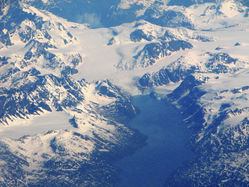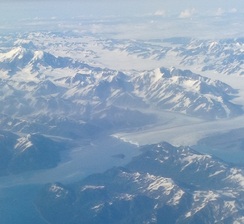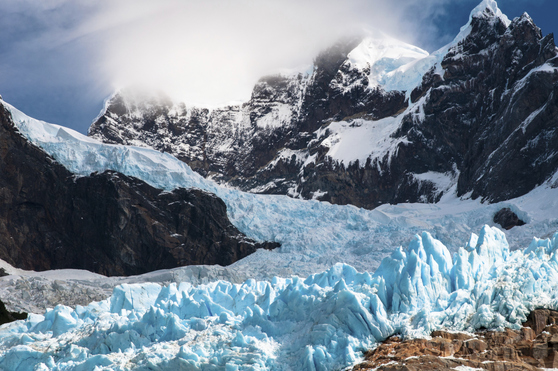What Are Glaciers?

Definition of a Glacier
Webster- Definition: A large body of ice moving slowly down a slope or valley or spreading outward on a land surface.
Presently, glaciers occupy about 10 percent of the world's total land area. During the Ice Age, ice covered 32 percent of land and 30 percent of the oceans. Most glacial ice is located in the Antarctica, but glaciers are found on nearly every continent, even Africa.
Webster- Definition: A large body of ice moving slowly down a slope or valley or spreading outward on a land surface.
Presently, glaciers occupy about 10 percent of the world's total land area. During the Ice Age, ice covered 32 percent of land and 30 percent of the oceans. Most glacial ice is located in the Antarctica, but glaciers are found on nearly every continent, even Africa.

How Glaciers Are Formed
Glaciers begin when snow remains in the same area year-round. The snow begins to compact or becomes denser. It slowly changes to ice pellets and as more snow falls it becomes a dense, grainy ice called firn or n'eve' ( granular snow accumulated on high mountains and compacts into glacial ice. ) After years layers of firn build on top of each other the firn grains fuse into a huge mass of solid ice.
Glaciers, Some Basic Ideas (Mt. Rainier National Park)
Glaciers begin when snow remains in the same area year-round. The snow begins to compact or becomes denser. It slowly changes to ice pellets and as more snow falls it becomes a dense, grainy ice called firn or n'eve' ( granular snow accumulated on high mountains and compacts into glacial ice. ) After years layers of firn build on top of each other the firn grains fuse into a huge mass of solid ice.
Glaciers, Some Basic Ideas (Mt. Rainier National Park)

How Do Glaciers Move
Glaciers move under its own weight and gravity. The glacier is so heavy and exerts so much pressure the firn melts. making the bottom slicker, allowing it to slide over uneven terrain. This process is called Basal sliding.
Internal Flow or Deformation: is another form of movement. Called glacial creep, ice due to slippage within and between the ice crystals
Bed Deformation : this is movement by deformation of soft or weak rock beneath a glacier.
How Do Glaciers Move? (Alaska Satellite Facility)
Glaciers move under its own weight and gravity. The glacier is so heavy and exerts so much pressure the firn melts. making the bottom slicker, allowing it to slide over uneven terrain. This process is called Basal sliding.
Internal Flow or Deformation: is another form of movement. Called glacial creep, ice due to slippage within and between the ice crystals
Bed Deformation : this is movement by deformation of soft or weak rock beneath a glacier.
How Do Glaciers Move? (Alaska Satellite Facility)

Why Are Glacier Blue
Glacial ice often appears blue when it has become very dense. Years of compression gradually make the ice denser over time, when glacier ice becomes extremely dense, the ice absorbs a small amount of red light, leaving a bluish tint in the reflected light. When glacier ice is white, that usually means that there are many tiny air bubbles still in the ice.
Why Are Glaciers Blue? (Alaska Satellite Facility)
Glacial ice often appears blue when it has become very dense. Years of compression gradually make the ice denser over time, when glacier ice becomes extremely dense, the ice absorbs a small amount of red light, leaving a bluish tint in the reflected light. When glacier ice is white, that usually means that there are many tiny air bubbles still in the ice.
Why Are Glaciers Blue? (Alaska Satellite Facility)
Glacier Types

Tidewater Glacier
Tidewater Glaciers: Mountain Glaciers that terminates in the ocean. They are responsible for calving, creating icebergs.
Tidewater Glaciers (National Snow and Ice Data Center )
Tidewater Glaciers: Mountain Glaciers that terminates in the ocean. They are responsible for calving, creating icebergs.
Tidewater Glaciers (National Snow and Ice Data Center )
 Malaspina Glacier is the largest Piedmont Glacier
Malaspina Glacier is the largest Piedmont Glacier
Piedmont Glaciers
Piedmont Glaciers: They are valley Glaciers that spread out over terrain and broaden their front after reaching the lowlands, taking the shape of a fan. The Malaspina Glacier is the largest piedmont glacier in North America; spanning 60 miles across. It covers 850 square miles, which is almost the same size as Rhode Island.
Piedmont Glaciers (National Snow and Ice Data Center )
Piedmont Glaciers: They are valley Glaciers that spread out over terrain and broaden their front after reaching the lowlands, taking the shape of a fan. The Malaspina Glacier is the largest piedmont glacier in North America; spanning 60 miles across. It covers 850 square miles, which is almost the same size as Rhode Island.
Piedmont Glaciers (National Snow and Ice Data Center )
 Cirque Glacier Above Margerie Glacier
Cirque Glacier Above Margerie Glacier
Cirque Glaciers
Cirque glaciers are named for the bowl-like depression they occupy, which are called cirques. Typically, they are found high on mountainsides and tend to be wide rather than long..
Cirque Glaciers:( USGS Glossary of Glacier Terminology )
Cirque glaciers are named for the bowl-like depression they occupy, which are called cirques. Typically, they are found high on mountainsides and tend to be wide rather than long..
Cirque Glaciers:( USGS Glossary of Glacier Terminology )

Only The Tip Of The Iceberg
The amount of information relating to glaciers is fascinating and extensive just like the glaciers. Here are few more quick links to types of glaciers, and links to more depth about glaciers.
Mountain, Valley and Alpine Glaciers are the same
(National Snow and Ice Data Center)
Hanging Glaciers: (National Snow and Ice Data Center)
Rock Glacier: (National Snow and Ice Data Center)
Retreating Glaciers: (National Snow and Ice Data Center)
Surging Glaciers: (National Snow and Ice Data Center)
Icefields: (National Snow and Ice Data Center)
Ice caps: (National Snow and Ice Data Center)
Useful Links for further research.
USGS (Glossary of Glacier Terminology By Bruce F. Molina and Types of Glaciers
National Snow and Ice Data Center
Alaska Satellite Facility, University of Alaska (Fairbanks)
Mount Rainier National Park (Glaciers and Glacier Change)
The amount of information relating to glaciers is fascinating and extensive just like the glaciers. Here are few more quick links to types of glaciers, and links to more depth about glaciers.
Mountain, Valley and Alpine Glaciers are the same
(National Snow and Ice Data Center)
Hanging Glaciers: (National Snow and Ice Data Center)
Rock Glacier: (National Snow and Ice Data Center)
Retreating Glaciers: (National Snow and Ice Data Center)
Surging Glaciers: (National Snow and Ice Data Center)
Icefields: (National Snow and Ice Data Center)
Ice caps: (National Snow and Ice Data Center)
Useful Links for further research.
USGS (Glossary of Glacier Terminology By Bruce F. Molina and Types of Glaciers
National Snow and Ice Data Center
Alaska Satellite Facility, University of Alaska (Fairbanks)
Mount Rainier National Park (Glaciers and Glacier Change)
